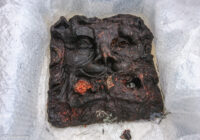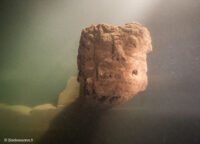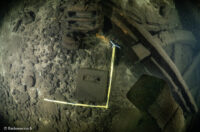 A carved wooden lion head has been recovered from an 18th century shipwreck 200 feet below the surface of the Gulf of Finland. This is a rare occasion as shipwrecks in Finland are protected and left as they are on the seabed; only pictures are taken, typically, not artifacts.
A carved wooden lion head has been recovered from an 18th century shipwreck 200 feet below the surface of the Gulf of Finland. This is a rare occasion as shipwrecks in Finland are protected and left as they are on the seabed; only pictures are taken, typically, not artifacts.
The shipwreck was discovered off the coast of Kirkkonummi in southern Finland decades ago, but has barely been explored. When it was photographed by volunteer divers from Badewanne, a non-profit organization dedicated to documenting shipwrecks in the Gulf of Finland, in 2005, the carved head was in place at the end of a long beam on the side of the bow. The beam was part of the mechanism that operated the ship’s anchors, and the ends of them were so frequently carved into feline faces that the beam was dubbed the cathead.
 When divers photographed it again this season, they found the cat head carving had fallen off the cathead and was face-down on the seabed. They found that one of the two iron bolts in the cat’s mouth that mounted it to the beam was missing and the other was heavily corroded.
When divers photographed it again this season, they found the cat head carving had fallen off the cathead and was face-down on the seabed. They found that one of the two iron bolts in the cat’s mouth that mounted it to the beam was missing and the other was heavily corroded.
To preserve the carving from being abraded to nothingness by the rough stony bottom, the Finnish Heritage Agency decided to raise it. The team used 3D photogrammetry to measure the carving precisely in order to customize the lifting case for a perfect fit so the head could be raised to the surface without damaging it. The operation was a complete success and the lion head has been transported to the National Museum Conservation Centre lab for study and conservation.
 The ship’s identity and country of origin is currently unknown. All we really know is its age and that it was a three-masted sailing vessels 100 feet long. Archaeologists hope examination of the carving will shed some light on the wreck’s history. Once the wood has been stabilized, the head will go on display at the Maritime Museum of Finland in Kotka.
The ship’s identity and country of origin is currently unknown. All we really know is its age and that it was a three-masted sailing vessels 100 feet long. Archaeologists hope examination of the carving will shed some light on the wreck’s history. Once the wood has been stabilized, the head will go on display at the Maritime Museum of Finland in Kotka.